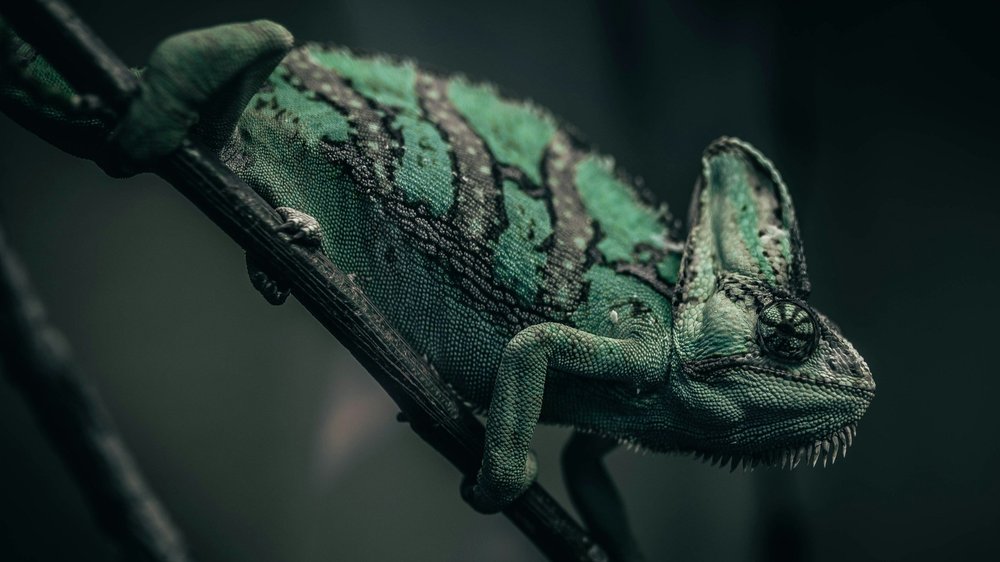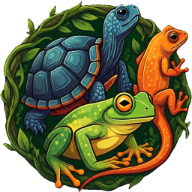
Chamaeleo calyptratus
Introduction
The Yemen chameleon (Chamaeleo calyptratus) is a chameleon species native to Saudi Arabia and Yemen. It is one of the most commonly kept chameleon species in the hobby. Males can grow up to 45 cm, while females reach about 35 cm, including the tail. Males often display more vibrant colors than females, making them more popular among keepers. Yemen chameleons live for approximately 4-7 years.
Chameleons have eyes that can move independently, allowing them to explore their surroundings. It's a common misconception that chameleons change their colors to blend into their environment. In reality, they alter their colors primarily for communication. Color changes can also indicate their mood or help regulate their body temperature. Adopting a dull color often signifies stress or a flight response.
Enclosure
Yemen chameleons are solitary animals. It is best to keep them alone, as they are territorial towards others. Females can also be territorial towards each other. Housing them with other chameleons can cause a lot of stress. They may also fight, which can potentially lead to death. Chameleons feel most at ease when they are alone. Just because they can tolerate each other does not mean they enjoy each other’s presence. Yemen chameleons do not drink from a water bowl and will drink water from the leaves of plants. A setup with real (pesticide-free, non-toxic) plants is recommended. Live plants also help maintain humidity levels. A dripper can also be used as a drinking source. An adult female must have access to a laying bin in the terrarium. Females can lay eggs even if they are unfertilized. If she cannot lay her eggs, she may suffer from egg-binding, which can be fatal.
The terrarium must be a minimum of 90x45x90 cm, as they grow quite large and thus require a lot of space. They are true climbers, so there should be vines or branches in the enclosure for them to climb on. The substrate must be at least 10 cm thick. Additionally, they require ample ventilation, so ensure that you have a terrarium with adequate ventilation grates or a mesh terrarium. A fully mesh terrarium offers high ventilation but does lead to significant loss of heat and humidity. The terrarium should be placed in a draft-free location.
Temperature & Humidity
The temperature should be between 25-30 degrees in the cooler section and 35 degrees directly under the lamp. Humidity should be maintained between 50-80%. Your chameleon must have the choice to sit in the warm or cool area. Ensure that the chameleon can never reach the heat source as they could burn themselves. You should maintain the humidity by misting. They require a fair amount of moisture, so it is advisable to install a fogger or misting system to keep the humidity levels stable. This ensures that the living environment of your chameleon remains optimal.
It's beneficial to equip the terrarium with a background, as this contributes to stress reduction. They also require a day-night cycle of about 10-12 hours of light each day. You can create this by adding a timer switch. A lock is useful to prevent children from accessing the terrarium.
To produce vitamin D3, they need UV light. Reptiles synthesize vitamin D3 in their bodies thanks to UV light. They need D3 to absorb calcium. A UV lamp should be replaced once a year. It is best to choose T5 or T8 lighting.
Substrate
Substrate plays a vital role in creating an appropriate environment for a red-eyed crocodile skink terrarium, as it not only maintains humidity levels but also allows for natural digging behavior, which is essential for reducing overall stress in these reptiles. It is advisable to use a moisture-retentive substrate that closely mimics their natural habitat, ensuring a minimum depth of 10 centimeters unless you are incorporating live plants into the enclosure. In such instances, you should also consider adding a layer of leaf litter, which enhances aesthetics while providing a beneficial environment for both flora and fauna. It is important to remove any feces and urates daily to maintain cleanliness, and any contaminated substrate should be promptly replaced to ensure the health of your reptiles. Additionally, a thorough replacement of the entire substrate should be conducted every 4 months, with adjustments made as necessary to accommodate the specific needs of your reptiles.
Food & supplements
A Yemen chameleon primarily eats insects such as crickets, grasshoppers, cockroaches (Dubia), silkworms, and flies. Mealworms, morio worms, and wax moth larvae can be offered occasionally. Once a chameleon reaches adulthood, it will no longer grow. Therefore, it is essential to provide good nutrition to prevent growth deficiencies. You can feed a chameleon as much as it wants; they tend to eat a lot when they are young, so ensure you always have enough food on hand. An adult chameleon does not need to eat every day. The food should not be larger than the mouth. A varied diet is important, as it contributes to the health of your reptile. Live feeder animals should be dusted with calcium and vitamins. Calcium is vital for strong bones, while vitamins support your reptile's overall health. This should never be done simultaneously; provide vitamins once a week and calcium on the other days.
Care & Behaviour
Reptiles are primarily visual animals and not pets for cuddling. Yemen chameleons are often very tolerant when they are still small and young. As they age, they tend to become somewhat more aggressive and may not be easy to handle. They can also bite quite hard. Whether your Yemen chameleon becomes aggressive depends on several factors. It is important to keep the terrarium clean. This can be achieved by making the terrarium bioactive (see the caresheet for bioactive setups). The substrate should be clean, the glass and leaves should be free of droppings, and any dead food items should be removed.
Conclusion & Difficulty
Chameleons, in general, are quite challenging pets to keep due to their sensitive nature in behavior and their high demands for appropriately designed enclosures. Despite the fact that chameleons can be difficult to care for, the veiled chameleon stands out as being notably more resilient than other species, making it a more suitable choice for those who are considering adding a chameleon to their collection.
Difficulty 3 out of 5.
